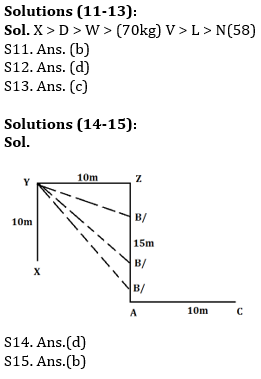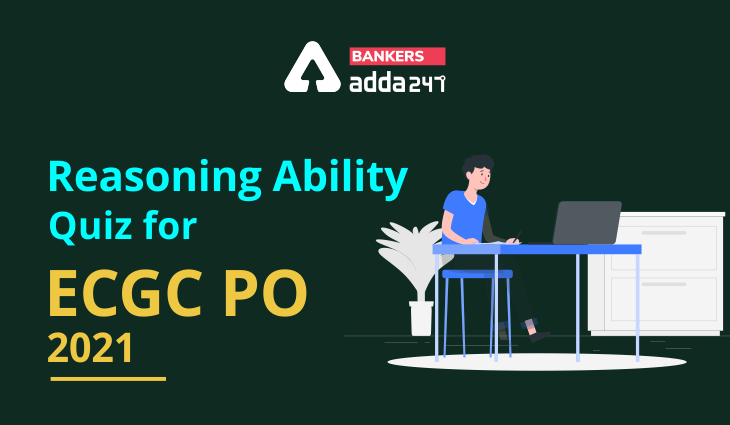Table of Contents
Directions (11-15): Study the following information carefully and answer the questions given below.
Eight professor- A, B, C, D, M, N, O, and P are working in three departments Engineering, Medical, and Management of an Institute with at least two of them work in each department and not more than three persons work in same departments. Each of them likes a different sports Golf, Volleyball, Archery, Boxing, Tennis, Rugby, Basketball and Cricket but not necessarily in the same order. P likes Archery and he works in Management department with only N. B and M do not work in the same department. O likes Boxing and does not work in Medical department. M and C works together but not in engineering department. D works with C in the same department and likes Golf. B likes Basketball and none of his colleagues in the department likes Tennis and Rugby. N likes Volleyball and M does not like Tennis.
Q1. Who among the following works same department as B?
(a) C
(b) D
(c) M
(d) O
(e) P
Q2. Which of the following sport likes by M?
(a) Cricket
(b) Rugby
(c) Basketball
(d) Volleyball
(e) Tennis
Q3. Four of the following five form a group, which among the following does not belong to that group?
(a) D-Medical
(b) C-Tennis
(c) N-Management
(d) A-Basketball
(e) O-Engineering
Q4. Who among the following likes tennis?
(a) C
(b) A
(c) M
(d) O
(e) N
Q5. Which of the following group of persons work in the same department?
(a) N-O
(b) P-C
(c) A-M
(d) O-B
(e) D-A
Directions (6-10): In these questions, a relationship between different elements is shown in the statements. The statements are followed by two conclusions. Give answer
Q6. Statement: L≤T≤I,M>I<X, P≤T≥B
Conclusion: I. B<X II. X>M
(a) if only conclusion II is true.
(b) if only conclusion I is true.
(c) if neither conclusion I nor II is true.
(d) if either conclusion I or II is true.
(e) if both conclusions I and II are true.
Q7. Statement: Z<U≤D, A≤U≤M<S, Q>M≤Y<G
Conclusion: I. Z<Y II. S>Q
(a) if both conclusion I and II are true.
(b) if only conclusion I is true.
(c) if neither conclusion I nor II is true.
(d) if either conclusion I or II is true.
(e) if only conclusion II is true.
Q8. Statement: N≤T≤I, M>B<X, W<T≤L≥B≥K
Conclusion: I. K≤I II. I<K
(a) if only conclusion II is true.
(b) if either conclusion I or II is true.
(c) if neither conclusion I nor II is true.
(d) if only conclusion I is true.
(e) if both conclusions I and II are true.
Q9. Statement: L≤T≤I,M>I<X, P≤T≥B
Conclusion: I. M≥P II. X>L
(a) if only conclusion II is true.
(b) if only conclusion I is true.
(c) if neither conclusion I nor II is true.
(d) if either conclusion I or II is true.
(e) if both conclusions I and II are true.
Q10. Statement: Z<U≤D, A≤U≤M<S, Q>M≤Y<G
Conclusion: I. D>S II. S≤D
(a) if only conclusion II is true.
(b) if either conclusion I or II is true.
(c) if neither conclusion I nor II is true.
(d) if only conclusion I is true.
(e) if both conclusions I and II are true.
Directions (11-13): Read the following information carefully and answer the given questions.
D, L, N, X, W and V are six friends. Each of them has different weight. L is heavier than only N. W is lighter than only two people. V is not the heaviest. The difference between the weight of third lightest and the lightest person is 12kg. D is heavier than W but is not the heaviest. The weight of V is 70 kg.
Q11. How many persons are heavier than V?
(a) Four
(b) Three
(c) Two
(d) One
(e) None of these
Q12. Which of the following statement is true if weight of L is 66 kg?
(a) The difference between the weight of V and L is 6 kg.
(b) Weight of W is 65 kg.
(c) Weight of D is 24 kg.
(d) The difference between the Weight of L and N is 8 kg.
(e) None is true
Q13. What could be the possible Weight of W?
(a) 62 kg
(b) 66 kg
(c) 80 kg
(d) 69 kg
(e) 59 kg
Directions (14-15): Study the following information carefully and answer the questions given below:
X is 10m to the south of Y, who is to the northwest of B. Y is 10m to the west of Z. C is 10m to the east of A, who is 15m to the south of Z. B is to the north of A.
Q14.In which direction is X with respect to B?
(a) Southwest
(b) Southeast
(c) Northwest
(d) CND
(e) None of these
Q15. What is the shortest distance between point C and Y?
(a) 35m
(b) 25m
(c) 30m
(d) 20m
(e) None of these
Practice More Questions of Reasoning for Competitive Exams:
Reasoning for Competitive Exams |
Reasoning Ability Quiz For ECGC PO 2021- 21st February |
Reasoning Ability Quiz For ECGC PO 2021- 20th February |
ECGC PO Study Plan 2021 |
Solutions


Practice with Crash Course and Online Test Series for ECGC PO 2021:
- ECGC Online Coaching Classes for Probationary Officier 2021
- ECGC PO Mock Tests 2021 – Banking Online Test Series (With Solutions) by Adda247
- ECGC PO 2021 Complete eBooks Kit (English Medium)
Click Here to Register for Bank Exams 2020 Preparation Material




 GA Capsule for SBI Clerk Mains 2025, Dow...
GA Capsule for SBI Clerk Mains 2025, Dow...
 The Hindu Review October 2022: Download ...
The Hindu Review October 2022: Download ...
 ECGC PO Scorecard 2025 Out, Check Marks
ECGC PO Scorecard 2025 Out, Check Marks




